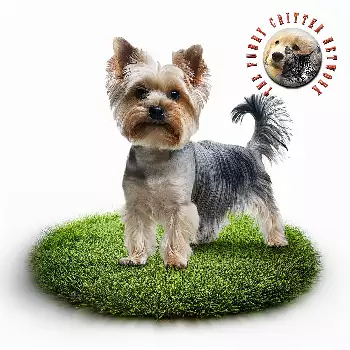Boston Yorkie
Hybrid Breed Description
The Boston Yorkie is a cross between the Boston Terrier and the Yorkshire Terrier. Because each hybrid inherits a unique combination of traits from both parents, we recommend thoroughly researching both breeds before choosing a Boston Yorkie. Pay special attention to temperament, health issues, and care requirements, as your dog may express characteristics from either parent breed.
Boston Terrier

The Boston Terrier stands between 15 to 17 inches tall at the shoulder and weighs from 10 to 25 pounds, divided into three distinct weight categories: under 15 pounds, 15 to under 20 pounds, and 20 to 25 pounds. These compact dogs display a sturdy, well-proportioned build with notably broad chests and an overall square appearance. Their distinctive square-shaped head sits flat on top with a short, broad, deep muzzle that gives them their characteristic pushed-in face typical of brachycephalic breeds. The breed's large, round, dark eyes are set widely apart and positioned squarely in the skull, creating an alert, kind, and intelligent expression. The nose is black and wide with well-defined nostrils. The Boston Terrier's most recognizable feature is their tuxedo-like coat pattern, earning them the beloved nickname American Gentleman. Their short, smooth, fine-textured coat displays striking markings with a base color of black, brindle, or seal paired with crisp white markings. Required markings include a white chest, white muzzle band, and white blaze between the eyes, while desired markings add a white collar and white on the forelegs extending up to the hocks on the rear legs. For show purposes, symmetrical markings are preferred. The breed's naturally short tail can be straight, curled, or corkscrew-shaped, typically not exceeding two inches in length, and docking is forbidden according to breed standards. As a brachycephalic breed, Boston Terriers have shortened muzzles and flat faces that create their distinctive appearance but also significantly impact their physical characteristics and health considerations. Their small, erect ears stand pointed like bat ears, contributing to their perpetually alert expression, and their slightly arched neck gives them a proud, dignified carriage. The breed maintains a level back with a compact, well-knit body that moves with surprising agility despite their solid, muscular build. Their limbs are strong and neatly turned, with legs set somewhat wide apart. Their physical structure reflects their fascinating evolution from pit-fighting dogs to beloved companions, successfully combining strength and athletic ability with an elegant, refined appearance.
Key Characteristics
Boston Terriers possess a gentle, happy-go-lucky personality with a merry sense of humor that brings joy to their families. Known for their friendly and affectionate nature, these dogs form strong bonds with their owners and thrive on human companionship. They are intelligent and generally eager to please, making them relatively easy to train, though they can display occasional stubbornness characteristic of their terrier heritage. Their sensitivity means they respond poorly to harsh corrections and do best with positive reinforcement training methods. The breed demonstrates excellent social behavior, getting along well with children, elderly family members, and other pets when properly socialized. Boston Terriers are naturally vigilant without being yappy, barking only when necessary, which makes them ideal apartment dogs. Their protective instincts toward their families can sometimes manifest as territorial behavior toward strangers or other animals. These devoted companions often become shadows to their owners, moving from room to room to stay close, and they excel as cuddle partners during downtime. Despite their moderate energy levels, Boston Terriers maintain a playful, entertaining spirit throughout their lives. They love games of fetch and enjoy being the center of attention, often performing silly antics to delight their audience. While they require regular exercise through daily walks and play sessions, they're content with moderate activity levels. Their adaptable nature allows them to adjust to various living situations, and they can participate successfully in dog sports like agility and obedience. However, their brachycephalic structure means they struggle with heat and intense exercise, requiring careful monitoring during warm weather and vigorous activity.
Brachycephalic Obstructive Airway Syndrome represents one of the most significant health concerns for Boston Terriers due to their shortened muzzles. This condition involves narrow nostrils, elongated soft palates, and potentially everted laryngeal saccules, all of which can obstruct breathing. Symptoms include noisy breathing, snorting, snoring, and difficulty exercising, with increased sensitivity to heat. Management requires keeping dogs cool, avoiding overexertion, and in severe cases, surgical intervention to improve airflow. Additionally, the breed commonly experiences eye problems including cataracts, glaucoma, corneal ulcers, and dry eye, with their prominent eyes making them particularly vulnerable to injury and irritation. Patellar luxation frequently affects Boston Terriers, causing the kneecap to slip out of its groove and resulting in limping or a skipping gait. This genetic condition ranges from mild to severe, with serious cases requiring surgical correction. The breed also faces risks of allergic dermatitis, causing excessive scratching, licking, and skin irritation that may require allergy testing and specialized diets. Spinal issues can develop due to their compact build, and some Boston Terriers are born with or develop back problems including herniated discs. Boston Terriers typically live 11 to 15 years with proper care and preventive veterinary attention. Regular veterinary checkups help identify and manage breed-specific conditions early. Maintaining a healthy weight is crucial for reducing stress on joints and airways, while dental care deserves particular attention as small breeds are prone to dental disease. Due to their brachycephalic nature, Boston Terriers face increased risks during anesthesia and frequently require caesarean sections for breeding. With responsible breeding practices that include health screening and attentive ownership that addresses their specific needs, Boston Terriers can lead happy, healthy lives.
Yorkshire Terrier

Yorkshire Terriers are among the smallest dog breeds in the world, typically standing 7 to 8 inches tall at the shoulder and weighing between 4 to 7 pounds at full maturity, with the American Kennel Club breed standard specifying dogs should not exceed 7 pounds. These tiny dogs maintain a compact, well-proportioned frame with a level back and surprisingly sturdy musculature despite their delicate appearance. Their small, slightly flat-topped head features a medium-length muzzle, while their medium-sized dark eyes sparkle with intelligence and a sharp, alert expression. The distinctive small, V-shaped ears sit high on the head and are carried erect, giving Yorkies their characteristic attentive expression that reflects their terrier heritage. The Yorkshire Terrier's most striking feature is their long, silky coat that flows gracefully and resembles human hair in texture, growing continuously throughout their lives. The coat displays a specific color pattern with steel blue or dark blue-gray covering the body and tail, paired with rich golden tan to lighter tan coloring on the head, chest, and legs. Yorkshire Terrier puppies are born with black and tan coloring that gradually transitions to the distinctive adult coat over several years, sometimes taking three or more years to reach final coloration. The coat's fine, straight, glossy texture requires substantial grooming commitment with daily brushing to prevent tangles, though many pet owners opt for shorter puppy cuts or teddy bear trims for easier maintenance while show dogs maintain floor-length coats. The breed sheds minimally, which combined with their hair-like coat has led to them being considered more suitable for people with allergies. Yorkshire Terriers carry themselves with confidence and pride despite their diminutive size, displaying an air of vigor and self-importance. Their body appears compact and neat with a slightly arched, proud neckline. The tail, which in some regions is docked though natural tails are increasingly preferred, sits fairly high and completes their elegant silhouette. Their physical appearance reflects their evolution from fearless working ratters in Yorkshire textile mills to fashionable companions, maintaining the terrier's sturdy structure within a miniature package. The breed's overall presentation combines refinement and elegance with the alertness and vigor expected of terrier breeds, creating an unmistakable appearance that has captivated dog lovers worldwide.
Key Characteristics
Yorkshire Terriers display personalities far larger than their tiny frames suggest, embodying boldness, confidence, and fearlessness. These spirited dogs remain true to their terrier roots with alert, intelligent natures and strong hunting instincts despite their current role as companion animals. Yorkies are affectionate and loyal, forming deep bonds with their families and thriving on attention and interaction. Their need for companionship means they don't tolerate being left alone well and may develop separation anxiety if isolated for extended periods. The breed demonstrates high intelligence and learns quickly, though this cleverness can manifest as stubbornness when they lack motivation to comply. Yorkshire Terriers respond best to positive reinforcement training methods and require patient, consistent handling. Their territorial and protective instincts make them excellent watchdogs, as they readily alert their families to unusual sounds or visitors, though this can lead to excessive barking without proper training. While many Yorkies get along well with children and other pets when socialized early, their small size and sometimes feisty attitude require supervision around young children and larger animals to prevent injury or conflict. Yorkshire Terriers maintain high energy levels and playful spirits throughout their lives. They enjoy interactive play, short walks, and mental stimulation through training and games. Despite their apartment-friendly size, they need regular exercise and engagement to prevent boredom-related behavioral issues. Their independent, sometimes domineering nature stems from their working heritage, and they may attempt to challenge authority or assert dominance. These characteristics, combined with their devotion and entertaining personalities, make Yorkies rewarding companions for owners who understand and appreciate their complex temperaments and can provide the attention, training, and socialization these confident little dogs require to thrive.
Tracheal collapse represents a primary health concern for Yorkshire Terriers, occurring when the cartilage rings supporting the windpipe weaken and the trachea flattens. This genetic condition produces a characteristic honking cough that worsens with excitement, exercise, or heat. Mild cases respond to cough suppressants and bronchodilators, while severe cases may require surgical intervention. The breed also commonly experiences patellar luxation, where the kneecap dislocates from its normal position, causing limping and discomfort. This genetic orthopedic condition varies in severity and may necessitate surgical correction in advanced cases. Additionally, Yorkies face elevated risks of dental disease, with tartar buildup, gum infection, and tooth loss occurring frequently due to their small mouths. Hypoglycemia poses a serious threat, particularly to Yorkshire Terrier puppies under four months old, though dogs of any age can experience dangerous drops in blood sugar. Symptoms include weakness, confusion, trembling, and in severe cases, seizures or coma. The breed is also predisposed to liver shunts, congenital conditions where blood bypasses the liver, preventing proper toxin filtration. Eye problems including cataracts, glaucoma, and retinal dysplasia can affect Yorkies, potentially leading to vision impairment. Legg-Perthes disease, affecting the hip joint, typically appears between four and twelve months of age. Yorkshire Terriers generally enjoy lifespans of 11 to 15 years with attentive care. Regular health screenings help detect hereditary conditions early, and responsible breeders conduct genetic testing. Maintaining appropriate weight is crucial for preventing joint and tracheal complications. Using harnesses instead of collars protects their vulnerable tracheas. Feeding schedules should prevent hypoglycemia, with frequent small meals for puppies. With proper nutrition, dental care, and regular veterinary visits, Yorkshire Terriers can thrive as healthy companions.
Important to Remember
Each hybrid dog is unique and may inherit any combination of traits from either parent breed. The information above represents the characteristics of the purebred parent breeds. Your Boston Yorkie may favor one parent over the other or display a blend of both. We strongly encourage you to read the complete breed profiles for both the Boston Terrier and Yorkshire Terrier to fully understand the range of possible temperaments, health concerns, and care requirements.